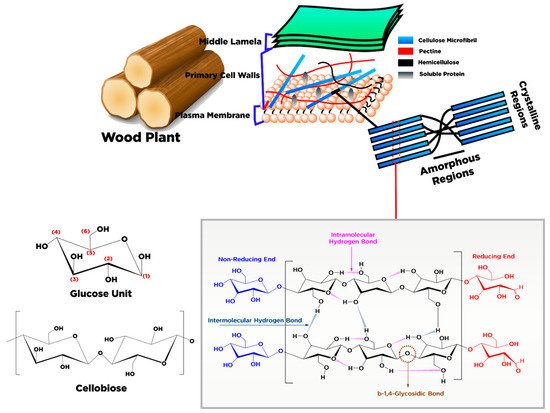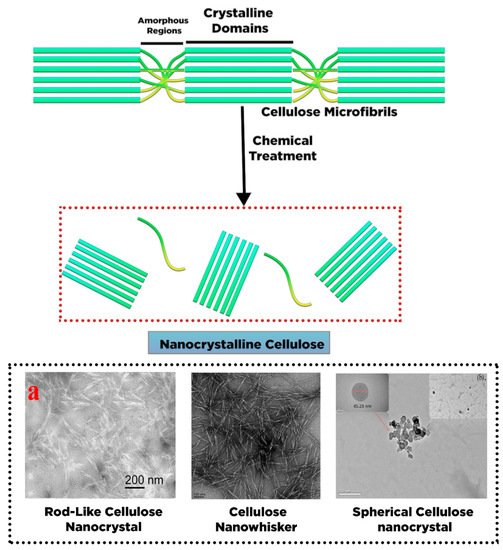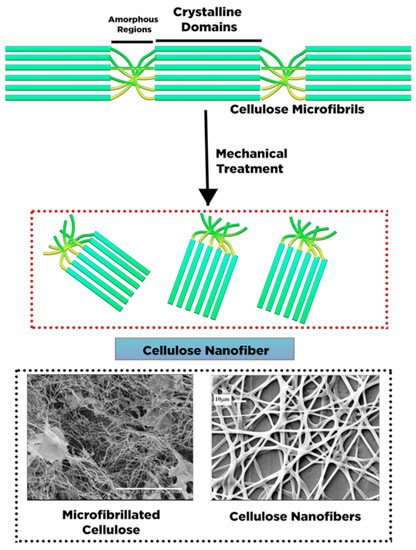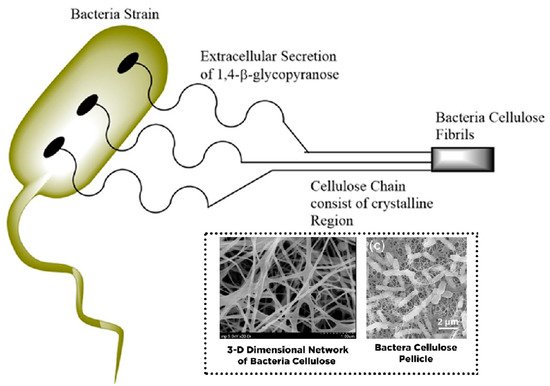2. Conversion of Cellulose into Nanocellulose and Its Characteristic
Cellulose is the most abundant natural polymer globally and is a renewable source and essential raw material for various industries. Cellulose is a crucial constituent compound for plants, marine animals, algae, fungi, bacteria, and amoebae
[12]. In 1838, French chemist Anselme Payen discovered and isolated cellulose from plant fibers using nitric acid and determined its chemical structure. The primary sources of cellulose are plant fibers with a high cellulose content, such as cotton (containing more than 90% cellulose content)
[16] and wood (up to 50% cellulose). Other compounds such as hemicellulose, lignin, pectin, and wax are also present; they can be recovered during the separation process.
Recently, various agricultural wastes with high cellulose content were explored as a source of cellulose, such as oil palm empty fruit bunches (OPEFB)
[17], palm and banana fronds, passionfruit peel waste
[18], bagasse, wheat straw, rice straw, bamboo stalks, hemp bark, potato tubers, mulberry bark, hemp avicel, and sugar beets
[19]. Cellulose derived from these non-plant precursors can have a molecular structure similar to that of plant cellulose. However, the main difference is that much less hemicellulose or lignin is present in these non-plant-based precursors; higher cellulose content with much lower impurities can be obtained from these precursors.
In terms of chemical structure, cellulose is composed of a linear homopolysaccharide consist of β-
d-glucopyranose units entirely condensed and bonded through β-1,4-glycoside linkages (
Figure 1). The structure foundation of the cellulose network is arranged by a chain glucose dimer comprising two anhydrous glucoses (AG) defined as cellobiose
[20] (
Figure 1). The raw material or the pretreatment (chemical or mechanical) of cellulose may affect the cellulose chain length and thus lead to molecular weight variation. The number of AG units in each chain is known as the polymerization degree (PD). The value of PD for cellulose powder varies from 100 to 300 units and around 26,500 for cellulose pulp
[21]. The PD value for cellulose from cotton is 15,000, and wood is approximately 10,000
[22].
Figure 1. Schematic of cellulose production from wood plant and structural chemistry of exhibiting arrangement betwixt individual fibers.
Each cellulose monomer contains three reactive hydroxyl groups in the repeating chemical structure of the β-
d-glucopyranose unit. In the same chain, these hydroxyl groups can make hydrogen bonds with the adjacent β-
d-glucopyranose units. At different chain locations, the bonds present are intramolecular and intermolecular hydrogen bonds responsible for the crystal arrangement, determining the cellulose’s physical characteristics. Based on molecular orientation and hydrogen network between molecules and intramolecular, cellulose is classified into different types, i.e., I, II, III, III
I, III
II, IV
I, and IV
II. For details about the classification of cellulose, the reader can refer to the work of Moon et al.
[23]. Some of the cellulose characteristics are mainly represented by hydrogen linkage coordination
[24][25].
Structurally, the cellulose is a linear chain polymer with a rod-like configuration, aided by the glucose residues’ equatorial conformation that is intensely aggregated together with the lateral size 3–5 nm
[25]. Primary chains of cellulose, especially polysaccharide chains, are found on the secondary walls of plants arranged in a parallel configuration. The cellulose’s basic fibers have a cross-sectional diameter between 10–450 nm with a length of several micrometers that depend on the diversity of material sources
[26]. Moreover, the elementary fibrils were arranged into large pack units called microfibrils, further foregathered into fibrils
[13]. There are regions within the cellulose fibrils where the cellulose chains are organized into a highly crystalline structure with a length of 50–150 nm and disordered amorphous regions with 25–50 nm
[23]. The cellulose chains construct the crystalline regions through Van der Waals forces, strong intra- and intermolecular hydrogen linkage, and β-1,4-glycosidic bonds. In contrast, amorphous regions are built up through the deficiency of hydrogen bonds in the crystalline region. The crystalline and amorphous regions in cellulose may vary depending on various sources.
The crystalline constituent within cellulose fibers can be refined through various chemical treatments by destructing and removing the disordered amorphous or para-crystalline regions. The purified crystal fragments with particle sizes on the nanometer scale are called nanocrystalline cellulose (NCC) (
Figure 2). Different shapes of NCC are present such as needle and elongated rod-like shape or spindle-like shape with high stiffness of crystalline fragments
[27], which are reported as cellulose whisker
[28], nanowhisker
[29], nanorod
[30], and spherical nanocrystal
[31].
Figure 2. Schematic representation nanocrystalline cellulose fabrication by chemical treatment ((
a) transmission electron microscopy (TEM) images of rod-like cellulose nanocrystals
[27], reprinted with permission; transmission electron microscopy (TEM) images of cellulose nano whisker reprinted with permission from
[32]. Copyright © 2019 Elsevier B.V.; (
b) transmission electron microscopy (TEM) images of spherical cellulose nanocrystal reprinted with permission from
[33]. Copyright © 2018 Elsevier B.V.).
A top-down process has been applied for NCC production in which a large unit of cellulose fibers (cm) is disintegrated through chemical or mechanical treatment into small units of nanocellulose (nm)
[34]. NCC’s chemical structure is constructed by intra- and intermolecular hydrogen linkage of cellulose macromolecules with a high crystallinity value varying from 54 to 88%
[35]. NCC’s particle size depends on the origin of the cellulose sources, with the diameter and length typically varying between 5 and 30 nm and between 100 and 500 nm, respectively
[36]. Thus, NCCs have become an attractive candidate as drug carriers, given their outstanding physical and chemical properties
[37][38][39].
Cellulose nanofiber (CNF), also known as cellulose nanofibril, micro-fibrillated cellulose, nano-fibrillar cellulose, nano-fibrillated cellulose, or cellulose microfibril, has a similar molecule structure to NCCs with nano-size particles. Similar to NCC, CNF can also be produced from various cellulose sources. However, the morphology and crystallinity of NCC and CNF are the unique features that differentiate these two cellulose-based compounds. CNFs have long, flexible cellulose chains of amorphous and crystalline regions isolated from cellulose fibrils through mechanical treatment (
Figure 3)
[36]. The diameter of CNFs varies from 1 to 100 nm, while their length varies between 500 and 2000 nm. The dimension of CNFs molecules is strongly influenced by mechanical treatment and defibrillation
[40].
Figure 3. Schematic representation of cellulose nanofibers fabrication by mechanical treatment (scanning electron microscopy (SEM) images of micro fibrillated cellulose reprinted with permission from ref.
[41]; Copyright © 2007 Elsevier Ltd.; scanning electron microscopy (SEM) images of cellulose nanofibers reprinted with permission from ref.
[42]. Copyright © 2006 Elsevier Ltd.).
NCC has high crystalline cellulose purity, resulting in a rigid structure, whereas the CNF structure consists of irregular amorphous parts, with some parts exhibiting a high degree of crystallinity. The amorphous regions in CNF control the structure flexibility of nanocellulose
[43].
Figure 3 presents an illustration of CNF extracted from cellulose fragments via mechanical defibrillation. The exerted force fractures the cellulose fibrils along its longitudinal axis
[23]. Compared with NCC, CNF exhibits unique properties such as extended length with excellent aspect proportion (length to diameter), superlative surface area, hydrophilicity, biocompatibility, and adjustable characteristic through surface modification
[44].
Microbial cellulose (MC), bacterial nanocellulose (BC), and bio-cellulose (BC) have been used as the other terms for bacteria cellulose (BC). In contrast to NCC and CNF, BC’s structure comprises sugars with low molecular weight. Many bacteria strains have been used to generate BC as an extracellular metabolic product, such as
Gluconacetobacter, Sarcina, Aerobacteria, Escheria, Achromobacter, Rhizobium, Rhodobacter, Azotobacter, and
Agrobacterium [45][46]. However, only
Gluconacetobacter xylinus has been commercially utilized to produce BC on an industrial scale
[16]. The bacteria strains are commonly incubated in nutrient-rich aqueous media and produce BC on the upper layer (interface with air) as an exopolysaccharide. In this case, the β-
d-glucopyranose units are initially present during the growth of cellulose molecules within the bacterial cell. The elementary fibril is released across the pores of the cellulose surface, which was further arranged and crystallized into microfibrils with twisting ribbons shape followed by pellicle formation (
Figure 4)
[47]. The fabricated BC comprises a nanofibers framework with a diameter of 20–100 nm with a length of several micrometers and a large surface area composed mainly of water (99%)
[48].
Figure 4. Schematic production of bacteria cellulose through extracellular secretion (scanning electron microscopy (SEM) images of 3-D dimensional network of bacteria cellulose
[49], reprinted with permission; (
c) scanning electron microscopy (TEM) images bacteria cellulose pellicle, reprinted with permission from ref.
[50]. Copyright © 2019 Elsevier Ltd.)
In terms of chemical composition, BC is indistinguishable from plant-based nanocellulose (e.g., NCC and CNF). However, BC has higher crystallinity (up to 84–89%) with fewer amorphous regions than NCC and CNF. Moreover, BC contains fewer impurities and contaminants such as hemicellulose, lignin, and pectin, mainly found in plant-based nanocellulose. BC is a biocompatible material with non-cytotoxicity and non-genotoxicity for biomedical applications, especially drug delivery
[51]. BC synthesis does not involve a complicated process such as mechanical and chemical treatment to cleave the hemicellulose or lignin within the lignocellulosic biomass, thereby allowing high cellulose purity.
BC’s properties can be modulated by various techniques such as substrate manipulation, culture condition and operation parameter, and proper bacterial strain selection
[52][45]. In contrast to NCC and CNF, BC provides unique characteristics such as high crystallinity of nanocellulose (84–88%) and polymerization grade, high water uptake capacity (exceeding 100 times of its weight), large surface area (high aspect proportion of fiber), outstanding tensile strength (Young modulus of 15–18 GPa), flexibility, foldability, moldability, mechanical stability, and high porosity
[51]. A summary of the characteristics of various types of nanocellulose is listed in
Table 1.
Table 1. Summary of the characteristics of various types of nanocelluloses.
| |
Types
|
Nanocrystalline Cellulose (NCC)
|
Cellulose Nanofibers (CNF)
|
Bacterial Cellulose
|
|
Parameter
|
|
|
Common names
|
Cellulose whisker, cellulose nanowhisker, cellulose nanowire, and cellulose nanorod or spherical cellulose nanocrystals
|
Cellulose nanofibril, micro fibrillated cellulose, Nanofibrillar cellulose, Nanofibrillated cellulose, and cellulose microfibril
|
Microbial cellulose (MC), bacterial nanocellulose (BC), and bio-cellulose (BC)
|
|
Morphological structure
|
Needles like shape, elongated rod-like shape, and spindle shape
|
Smooth, extended, and flexible chain
|
Twisted ribbons like shape
|
|
Structure of Nanocellulose
|
Crystalline domains
|
amorphous and crystalline domains
|
Crystalline domains
|
|
Chain Length
|
≥500
|
500–15,000
|
4000–10,000
|
|
Crystallinity (%)
|
54–88
|
-
|
84–88
|
|
Other Impurities and contaminant
|
Possible to contain hemicellulose, lignin, and pectin
|
Possible to contain hemicellulose, lignin, and pectin
|
Contain no hemicellulose, lignin, and pectin
|
|
Size (Length and Diameter)
|
Diameter: 5–30 nm and Length: 100–500 nm
|
Diameter: 1–100 nm and Length: 500–2000 nm
|
Diameter 20–100 nm and several micrometric lengths
|
|
Process System
|
Top-down system
|
Top-down system
|
Bottom-up system
|
|
Tensile strength (Gpa)
|
7.5–7.7
[23]
|
13
|
0.2–0.3
|
|
Modulus Young (Gpa)
|
110–220
[35]
|
Approximately 15
|
18–20
[51]
|
|
Density (gr/cm3)
|
1.6
[53]
|
1.42
|
1.1
|
|
Characteristics
|
Homogenous nanorod form, exceptional aspect ratio (length to diameter), appreciable specific surface area (SSA), biocompatibility, liquid crystalline attribute, inferior breaking expansion, high young’s modulus, hydrophilicity, outstanding mechanical stiffness, tunable surface characteristic due to the reactive hydroxyl group and low density
|
Extended length with excellent aspect proportion (length to diameter), superlative surface area, hydrophilicity, biocompatibility and adjustable characteristic through surface modification afforded by high extensive of hydroxyl groups in CNF.
|
High crystallinity of nanocellulose (84–88%) and polymerization grade, high water uptake capacity (exceeding 100 times of its weight), remarkable surface area (high aspect proportion of fiber), outstanding tensile strength (young modulus 15–18 Gpa), and flexibility, foldability, moldability, mechanical stability, highly biocompatible material, non-cytotoxic, un-genotoxic and high porosity
|
Based on the previous discussion, cellulose can be subjected to a mechanical, biological, and chemical treatment to produce three different NCs, i.e., nanocrystalline cellulose, cellulose nanofibrils, and biological cellulose. They are classified based on various aspects such as morphology, particle size, crystallinity, nanocellulose structure, extraction techniques, and cellulose sources
[47]. Moreover, other important factors such as interfibrillar arrangement, microfibril inclination, chemical constituent, cell dimension, and defects can also vary depending on the cellulose sources
[54]. Among all the mentioned characteristics, mechanical strength is essential in the drug delivery field
[55]. As summarized in
Table 1, NCC possesses a high modulus young, up to 220 GPa, which is higher than glass (86 GPa)
[53] and kevlar KM2 fiber (88 GPa)
[35]. Furthermore, the mechanical stiffness of NCC can reach up to 7.7 GPa, which is higher than 302 stainless steel (3.88 GPa)
[35] and kevlar KM2 fiber (1.28 Gpa)
[35].
3. Surface Chemistry of Nanocellulose for Drug Delivery
Biocompatibility, biodegradability, and drug carrier capability to confine, control, and localize the drug release towards the target sites are desirable for nano-drug carrier formulation. The ability of nano-drug carriers to transport the drug and specify the sites for targeted drug release is influenced by the particle size, the surface charge, modification, and hydrophobicity. These aspects govern the nano-drug carrier interface with the plasma membrane and its diffusion across the physiological drug barrier
[56]. Most NCs exhibit high specific surface area and negative interface charges as potential drug carriers, making them suitable as hydrophilic drug carriers. Therefore, the NCs’ surface can be attached to the desired drug
[57]. However, pristine NC cannot be used effectively as a drug carrier given its limited water solubility, moisture sensitivity, thermal instability, and lack of stability in various buffer solutions. Even though the pH adjustment of the environment can enhance the dispersibility of NCs, the scattering examination divulged the aggregation tendency of NCs, which translates to the colloidal instability of NCs. The size reduction obtained by converting cellulose into NC provides an exponential improvement of hydrogen bonding that triggers the NC aggregation. This limitation can be made worse by the drug coordination, which is exposed on the NC exterior, consequently altering the dispersibility and solubility
[58]. Therefore, various surface modification and pretreatment fiber methodologies have been developed to overcome limitations and advance specific characteristics
[59].
From a structural perspective, the three hydroxyl groups in each cellulose monomer are the most prominent characteristic that makes the NC surface reactive. The reactivity of hydroxyl groups influences the surface modification of anhydroglucose units. It was reported that in the molecular framework of cellulose, the hydroxyl group at the sixth position behaves as primary alcohol with a reactivity ten times larger than the other hydroxyl groups, while the hydroxyl group at the second position has two-fold higher reactivity than that in the third position, both of which serve as secondary alcohols. This phenomenon manifests from the steric hindrance of each hydroxyl group, in which the hydroxyl group at the sixth position attached to the carbon atom that is connected to only one alkyl groups while the carbon atom that carries the hydroxyl groups in the second and third positions bonded to two alkyl groups
[60]. Regarding the surface receptiveness of NC’s hydroxyl groups, the addition of solvent and reactant may alter the group’s receptiveness in diverse positions. De la Motte et al.
[61] modified NCC through cationic epoxide 2,3-epoxypropyltrimethyl ammonium chloride (EPTMAC) by spray technique. It was revealed that the hydroxyl bunch receptiveness of cationic modified NC follows the order of OH-C
6 = OH-C
2 > OH-C
3, which was validated through nuclear magnetic resonance (NMR).
Nanocellulose surface modification for drug delivery was developed by modulating the NC hydroxyl groups. In general, the main objective of nanocellulose surface modification is to incorporate new functional groups or drug components into the nanocellulose framework to escalate the degree of substitution and the efficacy of material grafting without altering the structure, morphology, and crystallinity of nanocellulose
[62].




